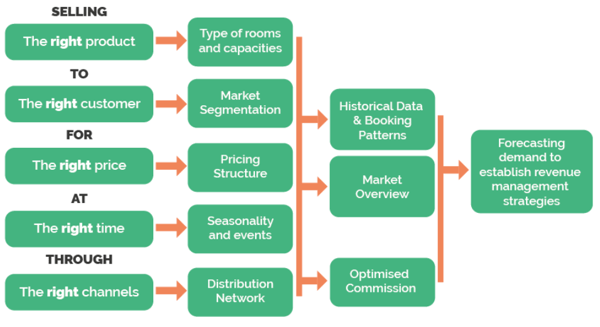We've spoken in detail about the pattern of OTAs entering the tourism sector, increasing market-share and in-turn increasing commissions. To combat OTA market-share growth and to be in control of their distribution, airlines and hotels turned to revenue management. On this page, we will introduce you to what revenue management is and how you can find strategies to implement in your business.

Revenue Management began in the 1980’s across the Airline Industry. To optimise financial results, airlines began to use ‘Dynamic Pricing’ where they would set seat prices based on anticipated consumer demand.
Broadly speaking, Revenue Management is the use of analytical data, which can help to predict the behaviour of customers, so that product availability and price can be optimised in order to generate the maximum amount of revenue possible.
In hotels, revenue management is a commonly used practise to sell smart. With the right execution, you will sell the right products to the right person for the right price at the right time through the right channels with the best commission efficiency. Yield management is just a small part of Revenue Management.

This is a simplified example as most hotels with have multiple room types and various demand days/periods.
Revenue management works well for hotels as they have:

Source: TrekkSoft
Market Segmentation - Understanding your market to see where demand comes from. What types of consumers do you have? What are their buying patterns, needs and expectations.
Pricing Structure - Optimse your pricing based on each particular segment. This could include corporate rates, wholesale rates or packages.
Seasonality and Events - Identify your shoulder months and high seasons, look at peak days of the week, and any upcoming ‘key’ dates or events.
Distribution Network - Selecting the right channels which reach each market segment including direct, OTAs, partners, resellers and advertisement.
Historical Data and Booking Patterns - Look at your analytics to identify booking patterns, trends and pace.
Market Overview - Look at your city tourism, economy, competitor volume/rates, and industry news.
Optimise Commissions - Chose the channels that maximise sales with the least commissions.
Forecasting Strategies - Anticipate future demand and revenue, enabling necessary adjustments to be made.
Dynamic Pricing - Room rate pricing based on demand. Lower rate rooms in shoulder months, higher pricing when higher demand is expected.
Direct Booking Incentives - Discounts, best rates or add ons made available for those customers who book direct. Another example is Loyalty Schemes.
Distribution Based on Demand - Using offers with Online Travel Agents, allocating to membership/loyalty schemes, tour bookings, corporate rates etc...
Last Minute Offers - Higher rates if there is walk-in demand, lower rates with a promotion if there are a number of rooms available and to sell is better than to have empty rooms.
In this 75-minute webinar, Amrita and Olan discuss candidly about revenue management and how tour operators can use these strategies to protect their profits.
Download the session materials:
BONUS: Q2 Booking and Distribution report
Though this may be the first time for many tour operators hearing of revenue management, it isn't completely new to the industry. There are operators around the world who have already seen, tested and successfully adopted revenue management strategies from airlines and hotels.
We're told that the tours & activities industry can't use dynamic pricing. It just doesn't work. In 2018/19, LAAX & Flims Ski Resort proved that belief wrong as they introduced dynamic pricing for their daily ski passes based on previous years' of data. They reduced prices on quieter time slots and days while increasing prices on busier time slots and days.
To increase direct bookings, you need have an engaging website, a calendar with live availability to 'book now' and (most importantly) a reason to book direct. Park Guell in Barcelona offers three clear reasons for a customer to book direct.
More Tips - Check out this blog post on how to convert OTA customers into direct bookers
The Van Gogh Museum struggled with volume as they had large queues from both OTA and ticket office bookings. Sometimes, there can be too much of a good thing.
As an extreme example of distribution management due to surging visitor volume, the Van Gogh Museum had an algorithm created based on their previous years' of data. This allowed them to anticipate demand and split their daily ticket allocation between their ticket office and OTAs. Distribution based on demand has now increased customer satisfaction and almost eliminated queue time during guest visits.
Video - Watch Kay Bartelink, Licensing Manager at the Van Gogh Museum at Arival Event
Read more - 3 successful revenue management strategies adopted by tour operators
Join the Revenue Management for Tour Operator group on LinkedIn where we continue the discussion.

We understand the tour and activity industry and you can rely on our team to onboard your business, introduce you to digital best practice, and guide you to success.
2010-2024 TrekkSoft | A TrekkSoft Group company
2010-2024 TrekkSoft | A TrekkSoft Group company